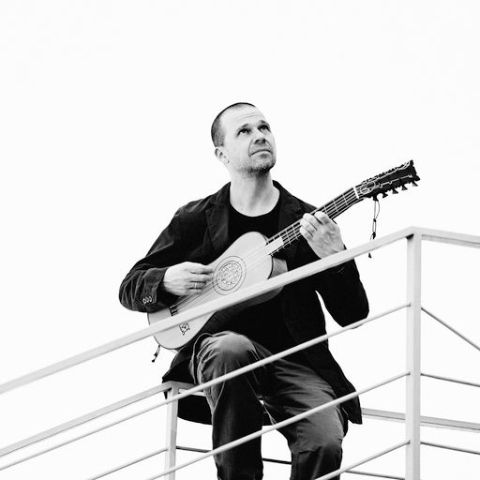Although this year’s 28th edition of the Concentus Moraviae international music festival embraces the theme Between Kroměříž and Vienna, the three-day project Island of Lutes by virtuoso lutenist and guitarist Pierre Pitzl holds a special place in its program design. From 16 to 18 June, the lute, vihuela or baroque guitar brought life to the castle grounds in Lysice and Rájec-Jestřebí with performances of works by Renaissance and early Baroque composers. The noteworthy culmination of the project was prepared by the organizers of the festival on Saturday, 17 June on the premises of the Rájce-Jestřebí Chateau. In addition to the vihuela and Baroque guitar player Pierre Pitzl, it also featured Renaissance lute player Ryosuke Sakamoto and theorbist David Bergmülller.
Yet the diverse selection of Renaissance and Baroque plucked instruments was not the only attraction of the evening. At the beginning of the concert, visitors were divided into three separate groups and before the grand finale in the ceremonial hall of the Rájec Chateau, they were treated to solo recitals by the participating artists. Each of the concert attendees received a letter (A, B, or C) along with their ticket, which marked the routes they would take. Route B, which was assigned to me, began in the Chateau Music Room, where Renaissance lute performer Ryosuke Sakamoto presented works by John Dowland and William Byrd. The cozy, almost intimate Music Room was an excellent choice for the interpretation of Renaissance compositions. Listeners were seated directly in front of the musician and could thus fully perceive the fragile yet intrinsically rich and complex lute works of John Dowland and William Byrd. Moreover, Sakamoto’s interpretation fully embraced this inherent subtlety - not only the opening The Lady Clifton’s Spirit by British lute virtuoso John Dowland was imbued with technical brilliance and enhanced by the lightness of expression and delicacy of the overall character of the staging. The delicate trills and ornamental notes may seemingly have been mere fleeting “flutter of wings” within the musical whole, but they were always strictly articulated and as melodically intelligible as possible. The following two movements (Kyrie and Gloria) from William Byrd’s Mass for Three Voices were performed in an arrangement for the solo lute directly from the pen of Ryosuke Sakamoto, and in addition to the flawless mastery of technique, the performance also boasted excellent phrasing and, above all, leading of the voice, from which the original polyphonic notation remained abundantly apparent. The first part of the salon music showcase closed with a trio of pieces by John Dowland - Sir John Smith his Almaine, Sir John Langton his Pavin, and the exuberant and partly improvised A Fancy.
The next item on the program took the listeners from Group B to the Chateau Chapel, where the Spanish instrument called the vihuela was played by the spiritual father of the project, Pierre Pitzl himself. The selection of vihuela literature included, for example, the musical fantasies of Alonso Mudarra, Francesco da Milano and Miguel de Fuenllana, and famous variations on the folk song Guardame las vacas and Pavane by Luis Milán. The selection concluded with the Soneto by Enríquez de Valderrábano. Pitzl’s playing - this being due of course due not only to the choice of instrument but also to the repertoire itself - is more adventurous and energetic than, for example, that of the delicate interpreter Ryosuke Sakamoto, but it fits the Spanish school of performance perfectly. The fantasy compositions offer considerable room for sharp changes in tempo, dynamics and timbre, which Pierre Pitzl made excellent use of, deliberately and with refined musical sensitivity. Delicate, fragile and almost pop-like sections alternated with dramatic and heated excitement and gradations with unabashed simplicity.
Following brief refreshments preceding the final item on the agenda, the Renaissance lute of Ryosuke Sakamoto resonated through the Ceremonial Hall with a Toccata and Gagliarda by Giovanni Girolamo Kapsberger. Here, Sakamoto had the opportunity to show a slightly more daring - dancing - interpretation than in his previous, more intellectually tuned polyphonic compositions. The dance-like character of the evening continued with Folia by composer Francisco Corbett, performed by Pierre Pitzl on a Baroque guitar. Here, the performer made the most of the musically impressive rasgueado style of playing (playing chords across all the strings), which is typical of the Baroque guitar. The following Capona by Ferdinando Valdambrini kept the wild rhythms going. The last performance before a final improvisation of the entire trio was by theorbist David Bergmüller with Robert de Visée’s Chaconne and Alessandro Piccinini’s Partite sopra la Folia. Although Group B did not have the opportunity to hear Bergmüller’s solo performance in the chamber salons, he was able to convince us of his interpretive abilities even in such confined spaces during the final concert - Bergmüller paid considerable attention to the leading of voices, and the polyphonic character of the pieces remained constantly apparent in his staging. The highlight of the evening was a joint improvisation in the form of a passacaglia, during which each of the musicians could apply their own distinctive approach to interpretation, while contributing their different characters to a wild and colorful dance movement.
Saturday’s Island of Lutes offered listeners a unique musical experience with a show of period instruments and a tour of the Rájec-Jestřebí Chateau. The only gripe - or perhaps a bit of a bittersweet sigh - comes from the fact that none of the visitors could attend all the solo recitals. However, those who couldn’t get enough of Saturday’s lutes and guitars surely attended Friday’s concert. Even Sunday saw a continuation of the lute evening with Ryosuke Sakamoto and David Bergmüller at the Rájec-Jestřebí Chateau. Doubtless, everybody got their fill in the end!
































No comment added yet..